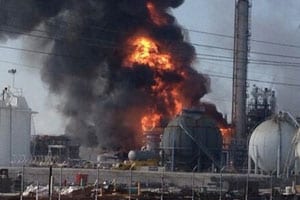
The Geisemar, Louisiana Williams Olefins chemical plant was the site of a blaze that shot a massive fireball and smoke column into the sky today, leaving 33 people injured. One person died in the blast. People in a two-mile radius were ordered to remain indoors, in part due to smoke, Lester Kenyon, a spokesman for […]
 The Geisemar, Louisiana Williams Olefins chemical plant was the site of a blaze that shot a massive fireball and smoke column into the sky today, leaving 33 people injured. One person died in the blast.
The Geisemar, Louisiana Williams Olefins chemical plant was the site of a blaze that shot a massive fireball and smoke column into the sky today, leaving 33 people injured. One person died in the blast.
People in a two-mile radius were ordered to remain indoors, in part due to smoke, Lester Kenyon, a spokesman for Ascension Parish said, according to Reuters. All of the roads leading into the plant have been closed, the company announced and “Emergency shut-down valves have been closed. The unit is isolated,” parent group Williams Cos. said in a statement. “We are in the process of accounting for all personnel.”
The blast occurred at 8:37 this morning and continued to blaze three hours later. About 600 people were working at the plant at the time of the explosion, according to state police. The chemical plant is located along the Mississippi River near Baton Rouge and about 60 miles from New Orleans, wrote Reuters.
“We did an aerial assessment, and our hazmat (hazardous materials) teams were able to get a broad view of the site. Now they’re putting on their bunker gear and going in on foot to the hot zone to do an assessment and determine a plan of action,” Louisiana State Police Captain Doug Cain said, according to Reuters. A search for potential victims continues, as well.
Of the 33 people injured, 30 were transported to hospitals by ambulance and three by helicopter, said Jean Kelly, spokeswoman for the Louisiana Department of Environmental Quality, according to Reuters.
“It’s an active scene. The fire department, the sheriff’s office, and hazmat (hazardous materials) team are responding to the explosion at the Williams Olefins plant,” Amy Johnson, a spokeswoman for the Ascension Parish Office of Homeland Security and Emergency Preparedness, said, according to Reuters. The company’s emergency response team was also assisting at the scene.
The Williams Olefins chemical plant produces about 1.3 billion pounds of ethylene and 90 million pounds of polymer grade propylene, according to its website. Ethylene and propylene are used in the petrochemical process in plastics manufacture, Reuters explained. “The chemical involved is a flammable, which is good in the sense that it is burning itself off, so there’s no impact outside the fence line of the facility,” Cain said.
The massive equipment, intense pressure, and high heat involved in manufacturing petrochemical make the industry prone to fires and explosions; most are brought under control with minimal injury and damage, according to Reuters. But, Southern Louisiana houses a great deal of the nation’s petrochemical facilities and at least two other blasts have been blamed on industry in the past two years, Reuters wrote.
There has been increased pressure on industry to strengthen safety following a 2005 blast at the Texas City refinery, in which 15 people were killed and 170 were injured. That was one of the worst industrial accidents in decades.
Another blast at a fertilizer plant in West, Texas killed 15 people and has renewed concern for communities nationwide over the potential hazards presented by stores of ammonium nitrate. A debate has also been sparked concerning new regulations for the agricultural chemical.
The fertilizer plant explosion also destroyed a nursing home and two schools, and left a 93-foot wide by 10-food deep crater. Some 200 people were injured and thousands of residents were forced to flee from and evacuate their homes over safety concerns and the ongoing investigation. At least 50 homes were demolished, parts of the town were leveled, and the energy was so intense that it registered as a small earthquake. In fact, the force of the blast toppled people blocks away, exploded windows, and caused the walls of many homes and buildings to buckle.


